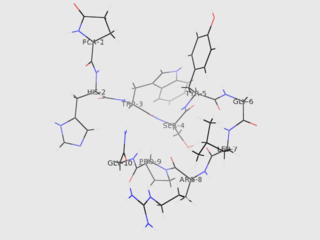
Endocrinology is a branch of biology and medicine dealing with the endocrine system, its diseases, and its specific secretions known as hormones. It is also concerned with the integration of developmental events proliferation, growth, and differentiation, and the psychological or behavioral activities of metabolism, growth and development, tissue function, sleep, digestion, respiration, excretion, mood, stress, lactation, movement, reproduction, and sensory perception caused by hormones. Specializations include behavioral endocrinology and comparative endocrinology.

A hormone is any member of a class of signaling molecules, produced by glands in multicellular organisms, that are transported by the circulatory system to target distant organs to regulate physiology and behavior. Hormones have diverse chemical structures, mainly of three classes:

Metamorphosis is a biological process by which an animal physically develops after birth or hatching, involving a conspicuous and relatively abrupt change in the animal's body structure through cell growth and differentiation. Some insects, fish, amphibians, mollusks, crustaceans, cnidarians, echinoderms, and tunicates undergo metamorphosis, which is often accompanied by a change of nutrition source or behavior. Animals can be divided into species that undergo complete metamorphosis ("holometaboly"), incomplete metamorphosis ("hemimetaboly"), or no metamorphosis ("ametaboly").

Estrogen, or oestrogen, is the primary female sex hormone. It is responsible for the development and regulation of the female reproductive system and secondary sex characteristics. There are three major endogenous estrogens in females that have estrogenic hormonal activity: estrone, estradiol, and estriol. The estrane steroid estradiol is the most potent and prevalent of these.

Testosterone is the primary male sex hormone and anabolic steroid. In male humans, testosterone plays a key role in the development of male reproductive tissues such as testes and prostate, as well as promoting secondary sexual characteristics such as increased muscle and bone mass, and the growth of body hair. In addition, testosterone is involved in health and well-being, and the prevention of osteoporosis. Insufficient levels of testosterone in men may lead to abnormalities including frailty and bone loss.

The hypothalamus is a portion of the brain that contains a number of small nuclei with a variety of functions. One of the most important functions of the hypothalamus is to link the nervous system to the endocrine system via the pituitary gland. The hypothalamus is located below the thalamus and is part of the limbic system. In the terminology of neuroanatomy, it forms the ventral part of the diencephalon. All vertebrate brains contain a hypothalamus. In humans, it is the size of an almond. The hypothalamus is responsible for the regulation of certain metabolic processes and other activities of the autonomic nervous system. It synthesizes and secretes certain neurohormones, called releasing hormones or hypothalamic hormones, and these in turn stimulate or inhibit the secretion of hormones from the pituitary gland. The hypothalamus controls body temperature, hunger, important aspects of parenting and attachment behaviours, thirst, fatigue, sleep, and circadian rhythms. The hypothalamus derives its name from Greek ὑπό, under and θάλαμος, chamber.

Vasopressin, also called antidiuretic hormone (ADH), arginine vasopressin (AVP) or argipressin, is a hormone synthesized as a peptide prohormone in neurons in the hypothalamus, and is converted to AVP. It then travels down the axon of that cell, which terminates in the posterior pituitary, and is released from vesicles into the circulation in response to extracellular fluid hypertonicity (hyperosmolality). AVP has two primary functions. First, it increases the amount of solute-free water reabsorbed back into the circulation from the filtrate in the kidney tubules of the nephrons. Second, AVP constricts arterioles, which increases peripheral vascular resistance and raises arterial blood pressure.

Homosexual behavior in animals is sexual behavior among non-human species that is interpreted as homosexual or bisexual. This may include same-sex sexual activity, courtship, affection, pair bonding, and parenting among same-sex animal pairs. Various forms of this are found in every major geographic region and every major animal group. The sexual behavior of non-human animals takes many different forms, even within the same species, though homosexual behavior is best known from social species.

Gonadotropin-releasing hormone (GnRH) is a releasing hormone responsible for the release of follicle-stimulating hormone (FSH) and luteinizing hormone (LH) from the anterior pituitary. GnRH is a tropic peptide hormone synthesized and released from GnRH neurons within the hypothalamus. The peptide belongs to gonadotropin-releasing hormone family. It constitutes the initial step in the hypothalamic–pituitary–gonadal axis.
The Endocrine Society is a professional, international medical organization in the field of endocrinology and metabolism, founded in 1916 as The Association for the Study of Internal Secretions. The official name of the organization was changed to the Endocrine Society on January 1, 1952. It is a leading organization in the field and publishes four leading journals. It has more than 17,000 members from over 120 countries in medicine, molecular and cellular biology, biochemistry, physiology, genetics, immunology, education, industry, and allied health. The Society's mission is: "to advance excellence in endocrinology and promote its essential and integrative role in scientific discovery, medical practice, and human health."
Martha McClintock is an American psychologist best known for her research on human pheromones and her theory of menstrual synchrony.
The Beef Hormone Dispute is one of the most intractable agricultural controversies since the establishment of the World Trade Organization (WTO).

C. Sue Carter is a biologist and behavioral neurobiologist. She is an internationally recognized expert in behavioral neuroendocrinology. In 2014 she was appointed Director of The Kinsey Institute and Rudy Professor of Biology at Indiana University. Carter was the first person to identify the physiological mechanisms responsible for social monogamy.
Hunger and satiety are sensations. Hunger motivates the consumption of food. Satiety is the absence of hunger; it is the sensation of feeling full.

Infanticide is the termination of a neonate after it has been born, and in zoology this is often the termination or consumption of newborn animals by either a parent or an unrelated adult. In rodents, it is not uncommon for the mother to commit infanticide shortly after parturition under conditions of extreme stress, or for an unrelated male to kill neonates.
The hormonal theory of sexuality holds that, just as exposure to certain hormones plays a role in fetal sex differentiation, such exposure also influences the sexual orientation that emerges later in the adult. Prenatal hormones may be seen as the primary determinant of adult sexual orientation, or a co-factor with genes, biological factors and/or environmental and social conditions.

L-368,899 is a drug used in scientific research which acts as a selective antagonist of the oxytocin receptor, with good selectivity over the related vasopressin receptors. Unlike related drugs such as the peripherally selective L-371,257, the oral bioavailabity is high and the brain penetration of L-368,899 is rapid, with selective accumulation in areas of the limbic system. This makes it a useful tool for investigating the centrally mediated roles of oxytocin, such as in social behaviour and pair bonding, and studies in primates have shown L-368,899 to reduce a number of behaviours such as food sharing, sexual activity and caring for infants, demonstrating the importance of oxytocinergic signalling in mediating these important social behaviours.
Hormones and Behavior is a peer-reviewed scientific journal covering behavioral endocrinology. It is published by Elsevier and is an official journal of the Society for Behavioral Neuroendocrinology. The journal covers hormone-brain relationships and publishes original research articles from laboratory or field studies on species ranging from invertebrates to mammals. It focuses on neuroendocrine and endocrine mechanisms affecting the development of behavior and on the ecological and evolutionary significance of hormone-behavior relationships.

Jacques Balthazart is a Belgian biologist who specializes in behavioral neuroendocrinology, author of multiple publications and working at the University of Liège.












